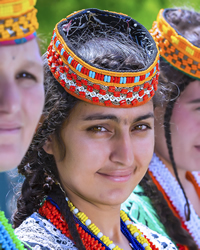Kalash (Chitrali) in Afghanistan

Photo Source:
Tahsin A Shah - Wikimedia
Creative Commons
|
Send Joshua Project a map of this people group.
|
| People Name: | Kalash (Chitrali) |
| Country: | Afghanistan |
| 10/40 Window: | Yes |
| Population: | 11,000 |
| World Population: | 40,000 |
| Primary Language: | Khowar |
| Primary Religion: | Islam |
| Christian Adherents: | 0.00 % |
| Evangelicals: | 0.00 % |
| Scripture: | Portions |
| Ministry Resources: | No |
| Jesus Film: | Yes |
| Audio Recordings: | Yes |
| People Cluster: | South Asia Muslim - other |
| Affinity Bloc: | South Asian Peoples |
| Progress Level: |
|
Introduction / History
Since the fifth century BC the Chitrali people have lived in the mountainous region that straddles Afghanistan and Pakistan, speaking their own Khowar language. For centuries they have grown fruit trees near their homes in order to offer luscious fruit to passers-by and visitors. Many of the Shia Muslim Chitralis have been forced to flee to refugee camps in the desert close to the Afghan border. The Chitralis have been streaming into Pakistani refugee camps, chased by Sunni Muslims.
Where Are they Located?
They reside in the mountains around the borders of China, Pakistan, India, and Afghanistan. These northern tribes are believed to be the original inhabitants of this area.
What Are Their Lives Like?
They take much pride in their history and language and claim to have remained, for the most, independent throughout most of its history. The Kho are also known as the Black Kafir, Chitrali, Chitralis, Citrali, Khowar, Koh, Qashqari, or the Qasqari. They speak Khowar. The Kho, as well as the other northern tribes, are known as brave, quiet, peace loving people. Most live in rugged mountain regions, where farming is very difficult. They are mostly farmers and shepherds. Their primary crop is grain, however in the more irrigated areas they are able to raise barley, wheat, maize, millet, and rice. They can only rely on one annual crop, so they must rely on transhumant herding, which means they have to transfer their livestock from one place to another for grazing. During the summer, the livestock is herded to alpine areas. It is only during the winter that the Kho live together in compact villages. Many families have houses in four or five different areas at higher altitudes. The Kho are divided into three social classes. The upper class is the ruling nobility, the middle class tend to be landowners, and the lower-class work as tenant farmers or hired laborers. Most only marry within their own group. While the societies tend to be patrilineal, where the line of decent is traced through the men, the women are not as secluded as other groups within the country are. The women do much of the farm work.
What Are Their Beliefs?
The Kho people are mostly Sunni Muslims. However, many combine Islamic practices with their traditional folk religions, which involves worship of spirits and fire, animism, and ancestor worship. Many consult shamans, priests, to cure the sick, communicate with spirits, and manipulate the spirits to control events. There are no known churches among the Kho.
What Are Their Needs?
The Kho are an isolated group due to the rugged terrain and political borders. Portable drinking water, sewage disposal, and drainage facilities are available for a small percentage of the northern tribe's population, which has led to many health problems. Poor nutrition is also a problem in the area.
Prayer Points
Pray for workers to do whatever it takes to take Jesus to this isolated Muslim people group. Pray for Kalash leaders to welcome Christ's ambassadors into their community. Pray for a Disciple Making Movement to flourish among the Khalash people this decade. Pray for opportunities for Christ's children to be a blessing to this Muslim people group.